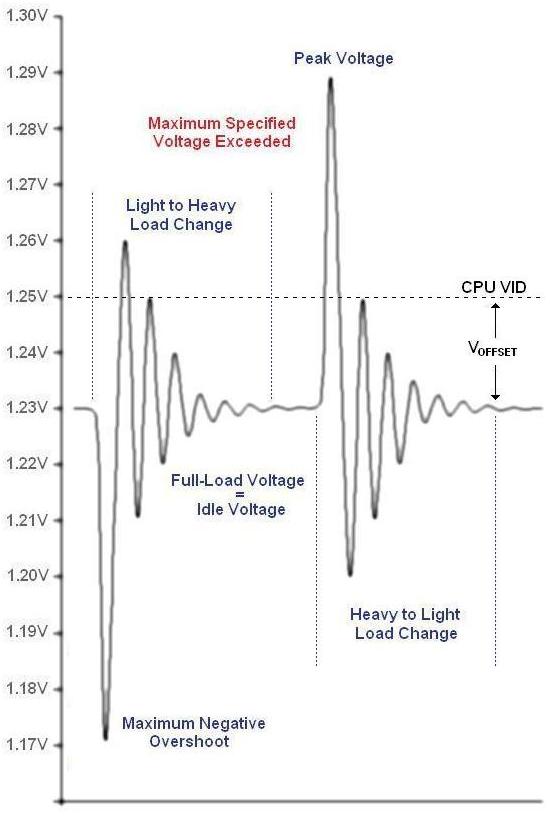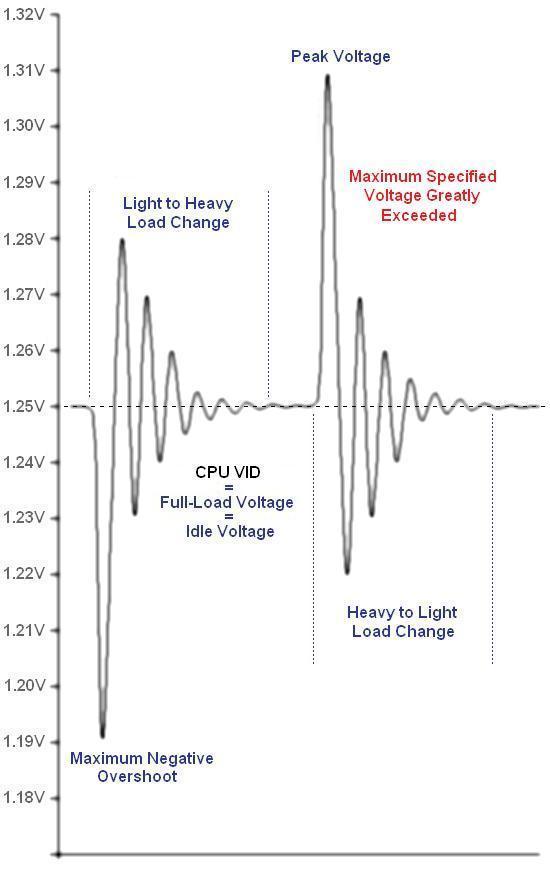Overclocking Intel's New 45nm QX9650: The Rules Have Changed
by Kris Boughton on December 19, 2007 2:00 AM EST- Posted in
- CPUs
Intel Processor Power Delivery Guidelines (Cont'd)
In this next case we eliminate Vdroop altogether and examine the chaos that ensues. As illustrated by our model, removing Vdroop does nothing to reduce the magnitude of the idle to full-load transient but does increase the settling time as the VRM must recover to a higher final regulation voltage. As in the case of no Voffset, it is possible to exceed the maximum allowable CPU voltage (VID). Clearly, removing Vdroop gains us nothing and only serves to create problems that are more serious.

No Vdroop means the VRM circuit must work harder at maintaining a constant voltage
So what happens when we remove both Voffset and Vdroop? The answer is simple - bad things. Although the difference between the maximum positive and negative peak overshoot are the same, severe violations to the CPU VID limit occur. If you're asking yourself what's the problem with this, consider the case of a CPU VID of 1.60000V - because the user feels this is the absolute maximum CPU voltage that they will allow. Just how high do you think CPU voltage will go after leaving a heavy load condition? We can't be sure without knowing more of the details, but we can certainly conclude that it will be well in excess of 1.6V. If you've ever run a benchmark only to have your system crash right as it finishes then you have experienced the consequences of this poor setup.

The user gives up all control over the CPU supply voltage with no Voffset or Vdroop
Finally, let's take one last real-world look at the consequences of removing Vdroop. ASUS' implementation of this feature, labeled as Load Line Calibration and included with their latest line of motherboards, is particularly worthy of our attention for a number of reasons. The first is that setting lower voltages with this option enabled actually results in a condition in which the CPU voltage under load is higher than the idle voltage. Imagine our confusion as we desperately struggle to understand why our system is Prime95 stable for days yet continues to crash under absolutely no load. What's more, in spite of the absence of droop and for reasons unknown, enabling this feature artificially raises our CPU's minimum stable core voltage at 4.0GHz from 1.28V to about 1.33V. As a result, our system uses more power under load than is otherwise necessary. Our efforts to reduce our processor's supply voltage backfired - instead of lowering the system's total power consumption we managed to affect a 20W increase.

Suffice it to say, we found it better to leave Load Line Calibration disabled
With Load Line Calibration disabled in BIOS, setting a CPU Voltage VID of 1.38750 resulted in a no-load voltage of about 1.34V and a full-load value of 1.28V. Enabling this feature and lowering the VID to 1.35000V produced a constant CPU supply voltage, regardless of load (or so it seemed), of 1.33V. Setting a lower VID resulted in a blue screen during Windows boot. Idle voltage was relatively unchanged at about 1.33-1.34V but the full-load voltage required increased by 50mV with no benefit. As you might guess, we recommend you leave this option disabled.
Hopefully we've shown you enough to understand exactly why Voffset and Vdroop are important. Please give second thought to your actions if you're in the habit of defeating these essential system safeguards.










56 Comments
View All Comments
mczak - Wednesday, December 19, 2007 - link
Granted, that's undervolted, at stock voltage it would be more like 70W instead of 54W :-).I think the criticism of intel's TDP was justified in P4 days, which really did exceed their TDP under high load. Nowadays, the TDP (at least the numbers from intel) is pretty meaningless to the end-user, since cpus with very different actual power consumption have the same rating (QX6850 and QX9650 for example...), but at least all of their cpus actually stay below the TDP.
noobzter - Wednesday, December 19, 2007 - link
I've been waiting for articles like this that delve further into OC's intricacies. Thank you for taking the time to write such an impressive piece!ahackett - Wednesday, December 19, 2007 - link
For someone like me who's fairly new to OC-ing and has been struggling to find a technical and pragmatic introductory guide to the skill, this article is like gold-dust! I look forward to the New Year when I hope to finally remove my E6300 from its temporary ASRock housing and get some decent overclocking done :)Thanks!
BradCube - Wednesday, December 19, 2007 - link
Agreed - Fantastic article. Thanks Kris :)SoBizarre - Wednesday, December 19, 2007 - link
Yeah, the rest of Anand's staff should start thinking about securing their future. Spreading some false rumors about him visiting "Tom's Hardware" office would be a good start. Add to this a couple of sexual harassment accusations and you have a winning combination that would quickly finish his career.Guys, let me spell it for you. If you don’t take action soon, you all will be F-I-R-E-D.
Vortac - Wednesday, November 20, 2013 - link
I still come back to read this article, from time to time. One of the best, really.